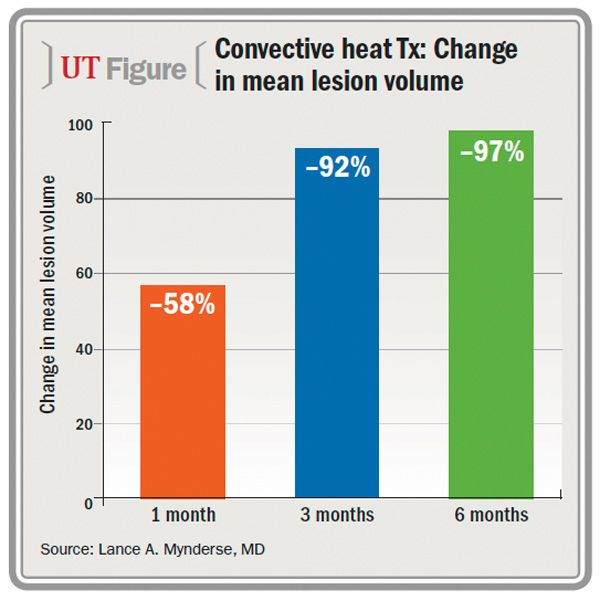Article
Convective heat system shows efficacy in treating BPH
Author(s):
Analyses of serial magnetic resonance imaging and three-dimensional renderings of those images provide proof of principle for using convective thermal heating to ablate prostate tissue, and early evidence suggests the efficacy and potential clinical advantages of using this novel technology to treat BPH, said first author Lance A. Mynderse, MD, at the European Association of Urology annual congress in Stockholm, Sweden.
Stockholm, Sweden-Analyses of serial magnetic resonance imaging and three-dimensional renderings of those images provide proof of principle for using convective thermal heating to ablate prostate tissue, and early evidence suggests the efficacy and potential clinical advantages of using this novel technology to treat BPH, said first author Lance A. Mynderse, MD, at the European Association of Urology annual congress in Stockholm, Sweden.

The Rezūm convective water vapor system (NxThera, Inc., Maple Grove, MN), which has received the CE mark to treat BPH, is an office-based transurethral treatment and delivers steam to tissue in the transition zone of the prostate. Tissue ablation results from phase-change, convective thermal energy transfer. When the steam condenses, it releases stored thermal energy (540 calories/mL of water) that denatures tissue cell membranes and causes cellular necrosis.
The investigation included 60 men treated at three centers who underwent the vapor treatment with between one and three injections per lateral lobe of the prostate, and also included treatment of the median lobe, if present. Gadolinium-enhanced MRIs were performed after 1 week and at 1, 3, and 6 months.
Continue to next page for more.
Treatments restricted to transition zone
Analyses of the MR images confirmed the presence of thermal lesions, quantified the significant volume of tissue treated in the procedures, and demonstrated that the treatments were restricted to the transition zone. The images also identified progressive reduction in both transition zone volume and total prostate volume and demonstrated rapid lesion resolution, with near complete necrotic tissue resorption at 6 months.
Mean lesion volume at 1 week was 9 cm3, and it was decreased by 58% at 1 month, 92% at 3 months, and 97% at 6 months. Compared with measurements obtained at 1 week, mean transition zone volume was decreased 31% at 3 months and 41% at 6 months; total prostate volume was reduced by 25% at 3 months and 33% at 6 months, reported Dr. Mynderse, assistant professor of urology at Mayo Clinic College of Medicine, Rochester, MN.
Dr. Mynderse is a clinical investigator in an ongoing FDA pivotal trial of the Rezūm system and has extensive experience using MRI for evaluating the tissue effects of ablative technologies for BPH.

Dr. Mynderse“By demonstrating correlation with histopathologic findings, Larson et al validated the use of MRI for evaluating the effectiveness of minimally invasive treatments for BPH. This is the first study using MRI to investigate the tissue effects of the water vapor treatment, and with the number of patients included and serial assessments obtained, it is the most comprehensive study ever undertaken to characterize the course of the treatment effect for any BPH procedure,” Dr. Mynderse said.
“While it was assumed that convective heating with steam would be an effective method for delivering targeted ablation of hyperplastic tissue within the prostate transition zone, the findings from this study confirm those concepts. In addition, the rapid time course of resolution of the thermal lesions suggests the water vapor treatment may have benefits of reduced need for post-treatment catheterization and faster improvement in obstructive urinary symptoms compared with other office-based BPH procedures. Data from upcoming reports of clinical outcomes will hopefully support these hypotheses.”
Continue to next page for more.
Steam appears to have unique advantages
Dr. Mynderse noted that steam, in addition to probably being the most efficient carrier of heat, appears to have some unique advantages due to its convective method of energy transfer.
“With lasers, radiofrequency devices, or microwave technology, where energy is transferred by conduction, the amount of energy delivered to the tissue dissipates as the distance from the source increases. The result is that the quality of the necrosis achieved varies within the area of treated tissue, which could impact outcomes.
“Convective thermal energy transfer causes more uniform tissue damage and allows for better control of the area of involvement. With the RezÅ«m vapor system, it appears that by appropriately adjusting the pressure of steam delivery and the tissue contact time, it is possible to selectively and effectively treat tissue within the transition zone,” he explained.
The FDA investigational device exemption pivotal study is randomizing men 2:1 to the Rezūm water vapor treatment and control procedure, respectively. Patients in the control group are eligible for crossover to Rezūm water vapor treatment after 3 months. Patient recruitment has been proceeding well, and it is hoped enrollment of the target population of 195 men will be completed during 2014.
NxThera, Inc. provided funding for the study.UT
Like this article? Check out these other recent Urology Times articles:
Ophthalmologists update advisory on alpha-blockers
PVP laser enabling BPH treatment for more patients
CMS issues two codes for BPH implant procedure
Subscribe to Urology Times to get monthly news from the leading news source for urologists.
Newsletter
Stay current with the latest urology news and practice-changing insights — sign up now for the essential updates every urologist needs.












